Physical Address
304 North Cardinal St.
Dorchester Center, MA 02124
Physical Address
304 North Cardinal St.
Dorchester Center, MA 02124
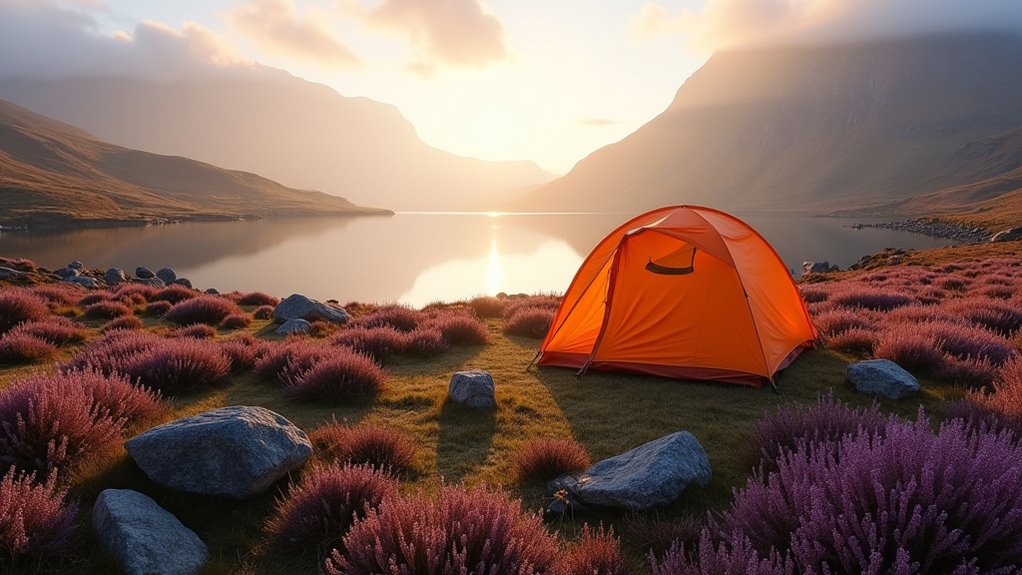
Intimidating Highland terrain requires insider knowledge—these 7 camping secrets separate successful adventurers from those who retreat defeated.
Like the ancient Scots who traversed these rugged peaks, you’ll need more than courage to conquer the Scottish Highlands safely. Wild camping here isn’t just about pitching a tent wherever you fancy—Scotland’s unique laws, unpredictable weather, and remote terrain demand proper preparation. You’re facing midges that’ll make you question your sanity, navigation challenges that humble experienced hikers, and weather that changes faster than Highland clan loyalties. Master these seven essential strategies, and you’ll transform potential disaster into the adventure of a lifetime.
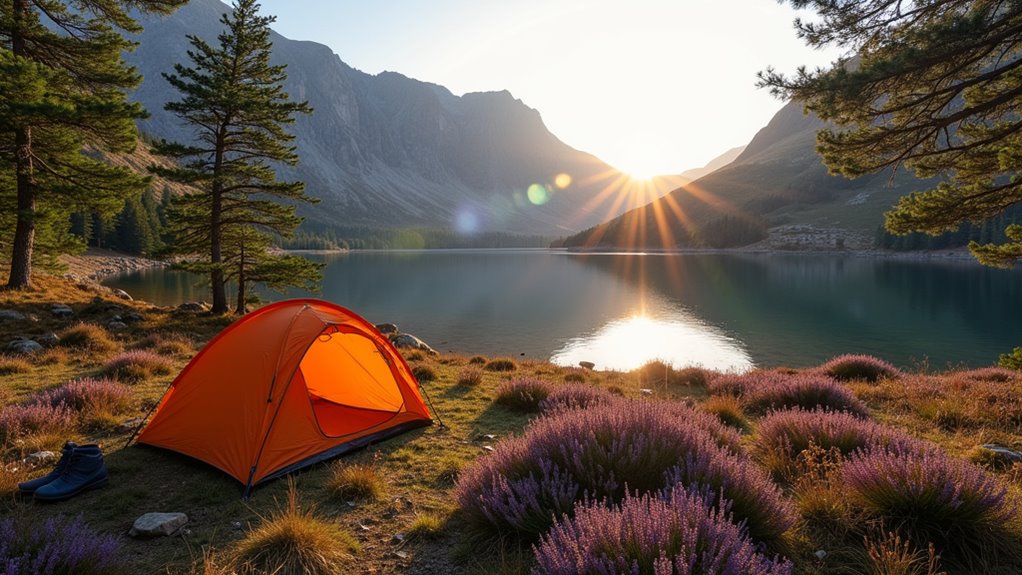
Before you pitch your tent anywhere in the Scottish Highlands, you’ll need to understand Scotland’s unique “Right to Roam” legislation, which grants you remarkable freedom to camp wild across most of the country’s stunning landscapes.
Scotland’s Right to Roam laws offer unparalleled wild camping freedom throughout the Highlands’ breathtaking terrain.
This law lets you camp almost anywhere, but you must follow the Scottish Outdoor Access Code. Camp responsibly by staying away from buildings, roads, and cultivated land. You can’t camp in gardens, golf courses, or school grounds.
Keep groups small—typically under six people—and stay a maximum of two nights in one spot.
Leave no trace behind. Pack out all rubbish, don’t light fires unless absolutely necessary, and respect wildlife. If landowners ask you to move, comply politely.
This freedom comes with responsibility, so follow these guidelines to preserve camping rights for everyone. Understanding which camping style works best for you will help you make the most of Scotland’s wild camping opportunities.
Once you’ve mastered the legal side of wild camping, you’ll face the Highlands’ notoriously unpredictable weather that can shift from sunshine to sideways rain in minutes. Your tent must handle fierce winds and driving rain, so invest in a four-season model with reinforced guy-lines. Pack a waterproof sleeping bag cover—even “waterproof” tents can leak in Highland storms.
Layer your clothing system with merino wool base layers, insulating mid-layers, and a hardshell jacket that breathes. Avoid cotton entirely; it kills when wet. Bring waterproof gloves, a warm hat, and extra socks. Pack everything in dry bags within your pack.
Don’t forget backup power sources for electronics—cold weather drains batteries fast. A reliable headlamp with spare batteries is essential for those long Highland nights. For quick morning energy, consider bringing a portable espresso maker that can brew quality coffee without needing a campfire or stove.
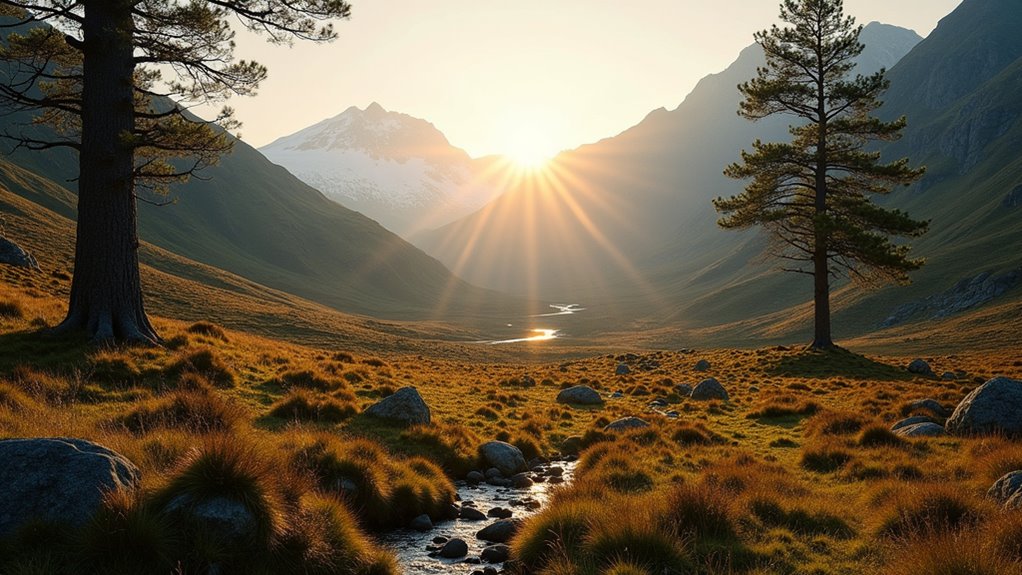
While stunning views might tempt you toward exposed ridges, you’ll sleep better—and safer—by selecting sheltered spots that protect you from Highland winds and potential hazards.
Choose shelter over scenery—your Highland adventure depends on prioritizing safety and comfort over Instagram-worthy exposed campsites.
Look for natural windbreaks like rock formations, tree lines, or hillsides that shield your tent from prevailing winds. Avoid camping in valleys where cold air settles overnight, creating uncomfortable temperature drops.
Consider these strategic location factors:
Smart site selection transforms your Highland camping experience from miserable to memorable. Once you’ve established your secure basecamp, you can focus on planning family camping activities that everyone will enjoy in Scotland’s breathtaking wilderness.
Getting lost in the Scottish Highlands isn’t just inconvenient—it’s potentially life-threatening, especially when weather conditions deteriorate rapidly and daylight fades faster than expected. You’ll need proper Ordnance Survey maps and a reliable compass as your primary navigation tools. Don’t rely solely on your smartphone’s GPS—batteries die and signal coverage is spotty in remote areas.
Download offline maps to your phone as a backup, but never make it your only option. Plan multiple route variations before you leave, including shorter alternatives if weather turns bad. Share your planned route with someone reliable who’ll raise the alarm if you don’t return on schedule.
Practice using your compass and map reading skills before your trip—emergencies aren’t the time to learn. If you do find yourself without a compass, learn essential navigation techniques using natural landmarks and celestial markers to maintain your bearings.
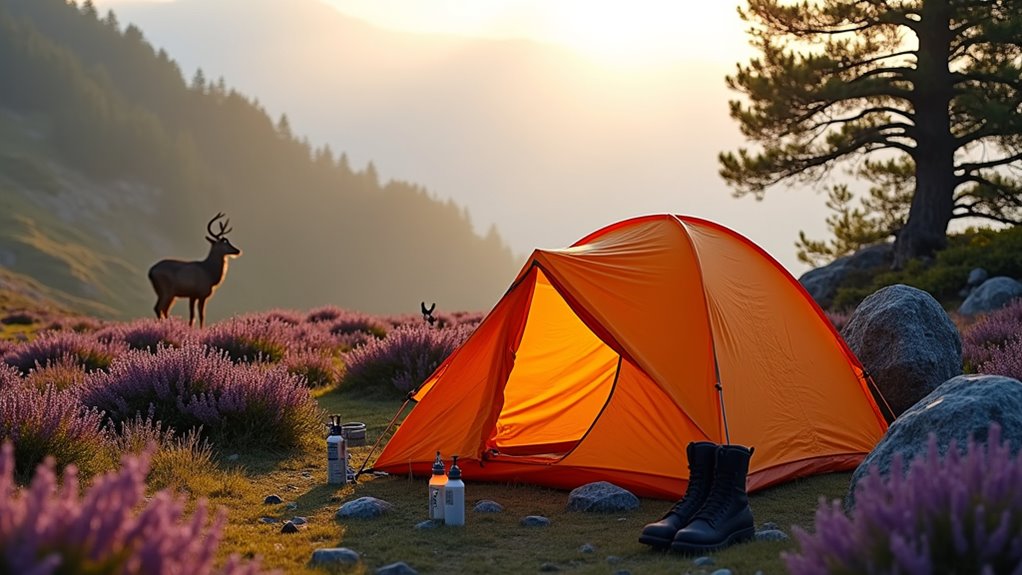
Although Scotland’s Highland wildlife won’t pose the same dangers as bears or venomous snakes, you’ll face relentless swarms of midges that can transform a peaceful camping experience into absolute misery.
These tiny biting insects are most active during calm, humid conditions at dawn and dusk. Pack high-DEET repellent and consider permethrin-treated clothing for serious protection.
You might also encounter red deer, Highland cattle, and sheep. Maintain respectful distances from all wildlife, secure your food properly, and never feed animals.
When camping in remote Highland areas, ensure you have a reliable camping water filter to safely treat natural water sources like streams and lochs.
Since the Scottish Highlands offer limited resupply opportunities and unpredictable weather, you’ll need to pack more carefully than for typical camping trips. Bring extra food for at least two additional days beyond your planned stay. Pack a reliable water filtration system since streams are abundant but may contain parasites. Include multiple fire-starting methods—waterproof matches, lighter, and fire steel—as wet conditions make ignition challenging.
Essential gear includes a headlamp with spare batteries, an extensive first aid kit, an emergency whistle, and repair tape for quick gear fixes. Don’t forget insect repellent for midges and extra plastic bags to keep items dry. Pack a detailed map and compass as phone signals are unreliable. Consider bringing a portable phone charger or power bank for emergencies when you do have signal. When camping with children in the Highlands, involve them in age-appropriate tasks like setting up camp to keep them engaged and make the experience more enjoyable for families.
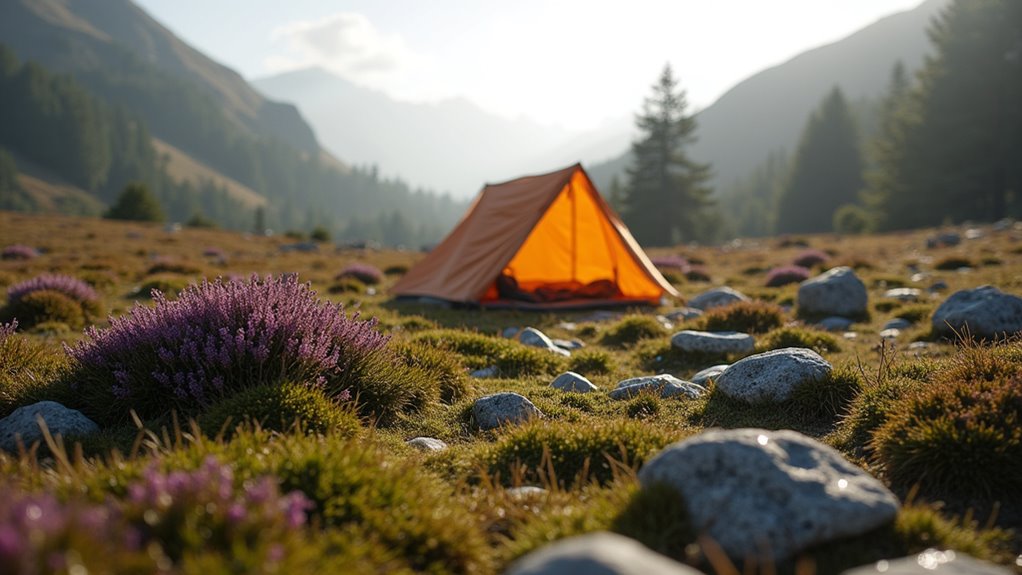
When you’re exploring the pristine Scottish Highlands, you’ll want to minimize your impact on these fragile ecosystems that support rare wildlife like golden eagles, red deer, and native wildflowers.
The Leave No Trace principles aren’t just guidelines—they’re essential for preserving Scotland’s natural heritage. You’re camping in landscapes that’ve remained unchanged for centuries, and it’s your responsibility to keep them that way.
These ancient Scottish landscapes depend on your commitment to responsible camping—protect what centuries have preserved.
Here’s how you can camp responsibly:
Your mindful camping ensures future generations can experience these magnificent highlands. After your Highland adventure, proper storing camping gear during winter months will help maintain your equipment’s condition and extend its lifespan for future trips.
You’re now equipped to tackle Scotland’s wild landscapes responsibly. Consider Sarah’s experience: she followed these guidelines during a three-day trek through Glen Coe, camping legally, weathering sudden storms with proper gear, and orienting safely with backup tools. She left zero trace and returned home with incredible memories. Your Highland adventure can be equally rewarding when you respect the land, prepare thoroughly, and embrace Scotland’s camping traditions. The mountains are waiting.